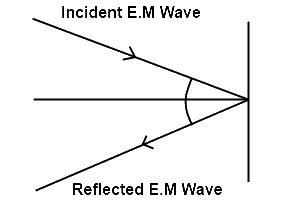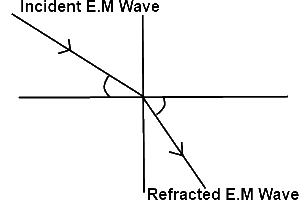Characteristics of Electromagnetic Waves
There are the following characteristics of electromagnetic waves.
Field of Electromagnetic wave
There are two fields of the electromagnetic waves
Electric Field
Magnetic Field
Field Angle of Electromagnetic Wave
In the electromagnetic waves, the angle between the electric field and magnetic field is 90 degree or magnetic and electric fields are perpendicular to each other.
Direction Of Electromagnetic Wave During Propagation
The electric field and magnetic field is perpendicular to the direction of propagation
Reflection of Electromagnetic Waves

The Electromagnetic wave is having the characteristics of reflection just like the light waves. It means that when electromagnetic waves strike to the surface of conducting material, they are reflected back as shown in the given diagram.
Refraction of Electromagnetic Waves

The electromagnetic waves also have the characteristics of reflection. It means that when the electromagnetic waves inters from one medium to another, it bends towards the normal or away from the normal while traveling in the next medium. When the electromagnetic waves inter form rare medium to dens medium, it bends towards the normal and when the electromagnetic inter from dens to rare medium it bends away from the normal.
Intensity of Electromagnetic Waves
The intensity of electromagnetic waves depends on the electrical field strength of the wave. It means that if the field strength of electromagnetic waves is more, its intensity will be more and vice versa.
The electrical field strength is measured in V/m volt per meter. For the microwave it's measured in micro volt per meter µv/m.Attenuation of Electromagnetic Waves
When the electromagnetic wave is propagated its energy is wasted while travelling from source to load. This loss of energy is known as attenuation of the electromagnetic waves. The attenuation occurs due to buildings, tree's, hills, rivers etc. which observe the electromagnetic energy during propagation.
Polarization of Electromagnetic Waves
There are the following types of electromagnetic waves polarization.
Vertical Polarization
If the position of the electric field is vertical with respect to ground during propagation, it is called vertical polarization of electromagnetic waves.
Horizontal Polarization
If the position of the electric field is horizontal with respect to ground during propagation, it is called horizontal polarization of the electromagnetic waves.
Linear polarization
If the position of electric field is sometimes vertical and sometimes horizontal with equal intervals and the direction of propagation does not change, it is called linear polarization.
Circular Polarization
If the position of electric field changes continuously during propagation of electromagnetic waves and its intensity remains the same, its is called circular polarization.
Elliptical polarization
If the position and intensity of electrical field changes continuously during propagation, it is called elliptical polarization.
Field Position of Electromagnetic Waves
As we know that the electrical field and magnetic field are perpendicular to each other and at the same time these fields are perpendicular to the direction of propagation, if we change the direction of any field it well result in corresponding change of the other field. It means that if E-field is vertical, the H-field will be horizontal. Now if we change the position of the E-field from vertical to horizontal, the position of H0field (magnetic field) will also change from horizontal to vertical. If we change the direction of E-field or H-field the direction of propagation will also change if we change the direction of E0field and H-field at the same time the direction of propagation will remain the same.
Velocity of Electromagnetic Waves
Velocity of electromagnetic waves in the air is the same as the velocity of light. It is 3 X 108 m/s or 3 X 1010 cm/s.
Separation of fields of E.M Wave
Electrical field and magnetic are always related to each other and whenever there is electric field, the magnetic field will also be present over there.
Energy of E.M Waves
When the electromagnetic waves are propagated, the energy of these waves is equally distributed in electric field and magnetic field throughout the propagation.
